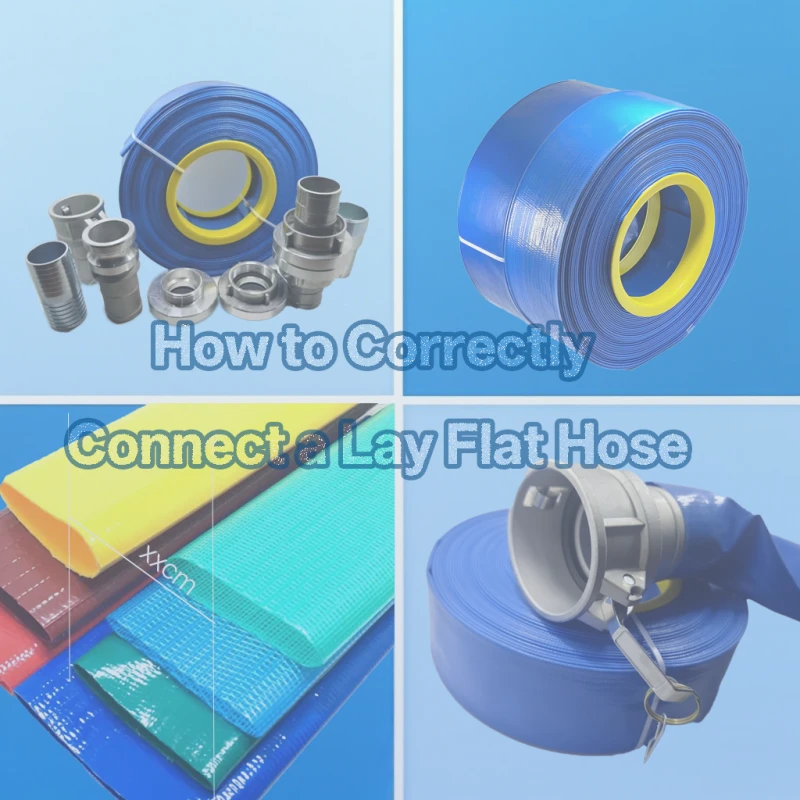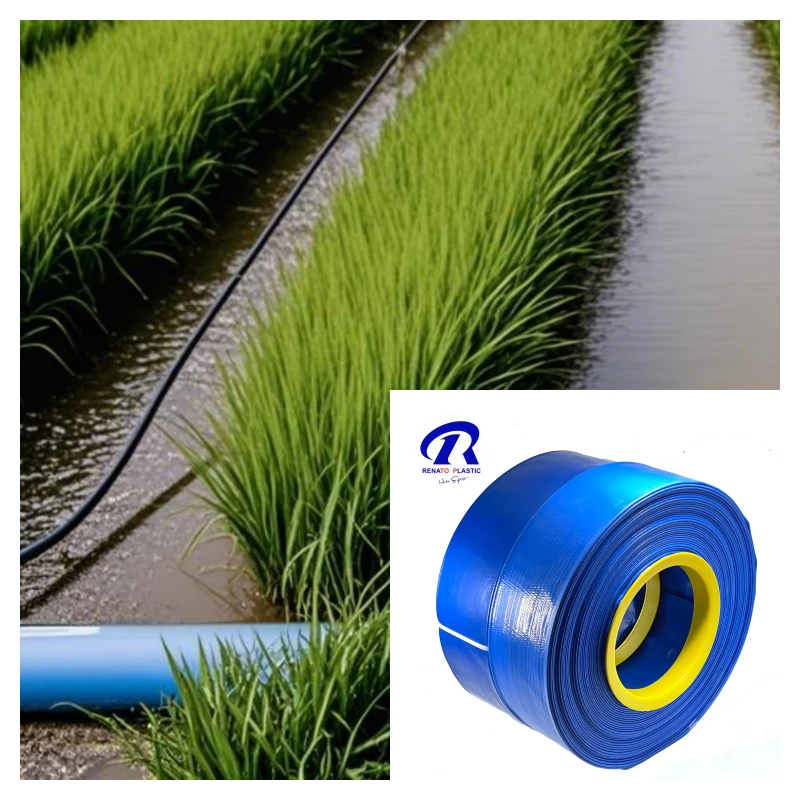Avoid Common Mistakes: How to Correctly Connect a Lay Flat Hose
Properly connecting a lay flat hose is crucial to prevent leaks and system inefficiencies. This guide covers essential preparation steps, correct installation techniques, and common mistakes to avoid. Learn how to select the right connectors, apply sealing materials, and conduct leak tests. Plus, discover key maintenance tips to extend hose lifespan. Trust QINGDAO RENATO PLASTIC CO., LTD for top-quality hoses and fittings.

Lay flat hoses are essential for fluid transport in irrigation, construction, and industrial applications. However, improper connections can lead to leaks, pressure loss, or even complete failure of the system. This guide provides an in-depth look at common mistakes and best practices for connecting lay flat hoses correctly.
Understanding Lay Flat Hoses
Lay flat hoses are flexible, lightweight, and easy to store, making them ideal for water discharge and fluid transfer. They are commonly used in:
Firefighting
Industrial fluid transport
Construction dewatering
Preparation
Check the Hose Condition
Before installation, ensure the hose is in good condition. Check for any signs of damage, twisting, or aging that might compromise performance.
Choose the Right Connector
Different connectors serve different purposes. Selecting the correct material and type is crucial:
Materials: Nylon (lightweight and corrosion-resistant), Stainless Steel (durable and strong), Brass (high-pressure resistant).
Types: Quick Connector (easy installation and removal), Threaded Connector (secure and leak-proof connection).
Tool Preparation
Gather all necessary tools for a successful installation:
Wrench
Sealing tape (Teflon tape)
Pipe clamp
Lubricant (for easier fitting installation)
Step-by-Step Connection
Step 1: Spread the Hose Flat
Lay the hose on a clean, flat surface to prevent tangling or twisting.
Step 2: Clean and Check the Connector
Remove any dirt or debris from the connector to prevent leaks or weak connections.
Step 3: Correctly Install the Sealing Material
Wrap Teflon tape around threaded connectors or insert a rubber gasket for added sealing protection.
Step 4: Tighten the Connector
Attach the fitting and tighten it carefully. Avoid over-tightening, which can damage threads or the hose, and under-tightening, which can lead to leaks. A torque wrench is recommended for precision.
Step 5: Test the Connection
Run a low-pressure water test to check for leaks. If leaks are detected, re-tighten or adjust the seal.
Common Connection Mistakes and How to Avoid Them
1. Choosing the Wrong Hose Size
Mistake: Using a hose with an incorrect diameter can reduce efficiency and cause pressure fluctuations.
Solution: Always match the hose diameter to the pump or system requirements. Refer to the manufacturer’s specifications for accurate sizing.
| Hose Size (Inches) | Flow Rate (Gallons per Minute) | Application Example |
|---|---|---|
| 1.5" | 50-80 | Small-scale irrigation |
| 2" | 80-150 | Firefighting |
| 3" | 150-300 | Industrial discharge |
| 4" | 300-500 | Large-scale irrigation |
2. Inadequate Hose Clamping
Mistake: Loose clamps can lead to leaks, while over-tightening can damage the hose.
Solution: Use appropriate clamps, such as stainless steel worm gear or T-bolt clamps, and ensure they are tightened to the manufacturer’s recommended torque.
3. Poor Fitting Selection
Mistake: Using incompatible fittings can result in weak connections and failure under pressure.
Solution: Choose fittings designed for lay flat hoses, such as camlock or storz fittings, and ensure they match the hose material and diameter.
Fitting Type | Application |
Camlock | Quick connections for irrigation and firefighting |
Storz | Fire hose and industrial fluid transport |
Threaded | Secure connections for long-term installations |
4. Improper Hose Insertion
Mistake: Failing to fully insert the hose into the fitting can create weak points and potential leaks.
Solution: Ensure the hose is fully seated in the fitting before securing with a clamp or ferrule. Lubricating the end can facilitate insertion.
5. Ignoring the Minimum Bend Radius
Mistake: Bending the hose too sharply can restrict flow and lead to premature wear.
Solution: Follow the manufacturer’s recommended bend radius to maintain optimal performance.
Hose Size | Minimum Bend Radius (Inches) |
1.5" | 6 |
2" | 8 |
3" | 12 |
4" | 16 |
6. Twisting the Hose During Installation
Mistake: Twisting weakens the hose structure and reduces pressure tolerance.
Solution: Lay the hose flat before installation and avoid excessive twisting when connecting fittings.
7. Neglecting Hose Maintenance
Mistake: Failing to inspect for wear and tear can lead to unexpected failures.
Solution: Regularly check for cracks, leaks, or kinks and replace damaged sections as needed.
Best Practices for Lay Flat Hose Connections
Select the Right Hose and Fittings: Ensure compatibility with your application.
Use High-Quality Clamps: Stainless steel clamps provide superior durability and resistance to corrosion.
Ensure Proper Insertion: Fully insert the hose into the fitting and secure it properly.
Avoid Kinks and Twists: Maintain a straight alignment during installation.
Perform Regular Maintenance: Check for leaks and replace worn-out parts as needed.
Maintenance Tips
Rinse the hose after use to remove dirt, chemicals, or sediments that can lead to clogging or material degradation.
Avoid direct sunlight and extreme temperatures during storage to prevent UV damage and material weakening.
Store properly: Coil the hose loosely and place it in a dry, shaded area to prevent bending or cracking.
Use protective covers if the hose is exposed to rough environments, such as construction sites, to prevent cuts or abrasions.
Regularly inspect fittings and seals for rust, cracks, or wear, and replace them when needed to prevent leaks.
Avoid dragging the hose across rough surfaces to prevent damage and prolong its lifespan.
Why Choose QINGDAO RENATO PLASTIC CO., LTD?
QINGDAO RENATO PLASTIC CO., LTD has over 15 years of experience in manufacturing PVC hoses, including lay flat hoses, suction hoses, and reinforced hoses. Our factory in Shandong province operates with:
10 workshops
60+ production lines
120+ skilled workers
Advanced quality control teams
We supply top-quality hose assemblies, including camlock fittings, storz fittings, and hose clamps, ensuring durability and reliability for various applications. Our products are trusted in over 60 countries worldwide.
If you need a dependable partner for hoses and fittings, contact us today. We prioritize customer satisfaction with a 7x24 hours quick response policy.
Conclusion
Connecting a lay flat hose correctly is essential for efficiency, longevity, and leak prevention. By following the right preparation, connection steps, and maintenance tips, you can avoid common mistakes and ensure a secure setup.
Have any questions or experiences to share? Let us know in the comments!
